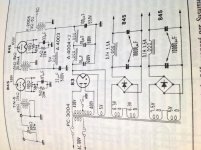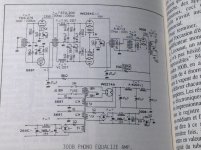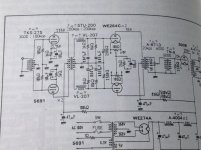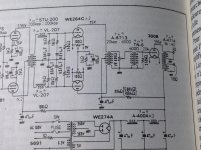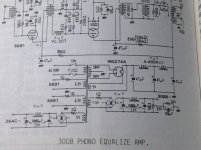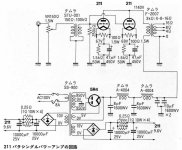The AC loading on the 300B thru the 5K:10K xfmr would provide some active hum cancellation of the power supply, but the DC loading of the power supply by the idle current of the 300B would make the hum worse. Pulling out the 300B probably does nothing much, except extinguish a glowing heater. Like recent political events, no harm done except draining someones wallet.
...no harm done except draining someone's wallet.
I think the only thing Sakuma is selling is food.
John
Member
Joined 2009
Paid Member
I didn't think he was selling anything anymore, I thought he has passed away - could be wrong ? - but I do like his style - because he had some style, it was not a 'dry engineering' approach. There's room in the world for both approaches and this hobby is all the more enjoyable for it.
I think this describes the Sakuma phenomena quite well: http://www10.big.or.jp/~dh/sakuma/
A number of my friends have made the visit to the restaurant Concord and describe Sakuma as a very gracious host.
He has written extensively in MJ and elsewhere about his passion for audio, and has made his designs freely available for fellow enthusiasts to experiment with.
His ideas are unconventional, and not without controversy particularly here in the West, not sure most Japanese diy'ers are all that concerned about the fringe element in their hobby. (Or if they even regard it as such)
A number of my friends have made the visit to the restaurant Concord and describe Sakuma as a very gracious host.
He has written extensively in MJ and elsewhere about his passion for audio, and has made his designs freely available for fellow enthusiasts to experiment with.
His ideas are unconventional, and not without controversy particularly here in the West, not sure most Japanese diy'ers are all that concerned about the fringe element in their hobby. (Or if they even regard it as such)
Attachments
Member
Joined 2009
Paid Member
That video is over 8yrs old
I find this morning Sakuma San schematics from legendary french magazine " L'Audiophile "
source nr 28/94 directed by master Jean Hiraga.
source nr 28/94 directed by master Jean Hiraga.
Attachments
No bleeder tubes but other Sakuma San schematic hope Thomas Mayer and Diyers find them interesting.
Best regards
Best regards
Attachments
-
 B0E61A7F-8F10-45C1-A82A-BFA2C528F822.jpg467.7 KB · Views: 138
B0E61A7F-8F10-45C1-A82A-BFA2C528F822.jpg467.7 KB · Views: 138 -
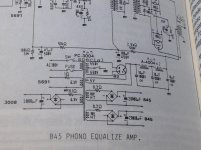 77966AB3-B90F-4B97-87F5-AC911BB855B4.jpg467.3 KB · Views: 144
77966AB3-B90F-4B97-87F5-AC911BB855B4.jpg467.3 KB · Views: 144 -
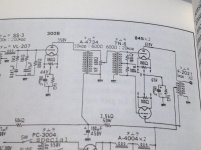 F56AC071-8E56-41A6-99EE-1A8FE4CC9D4A.jpg439.7 KB · Views: 144
F56AC071-8E56-41A6-99EE-1A8FE4CC9D4A.jpg439.7 KB · Views: 144 -
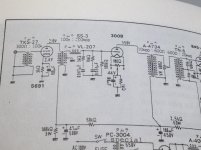 55ADC1F6-6317-44F2-8D5F-24B0B792E535.jpg455.8 KB · Views: 162
55ADC1F6-6317-44F2-8D5F-24B0B792E535.jpg455.8 KB · Views: 162 -
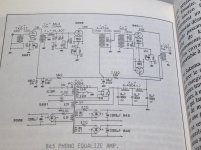 A9AC6804-FA5C-45D1-9A5D-72CA1E8FC979.jpg479.3 KB · Views: 194
A9AC6804-FA5C-45D1-9A5D-72CA1E8FC979.jpg479.3 KB · Views: 194
Stumbled on this thread from 10 years ago! I have the MJ articles that might give an insight into these particular circuits.
In the 2009-2010 Sakuma is very much occupied with making a phono pre-amp, or EQ amp as he calls them, with the 841 tube. In that year he will make about 4 different designs with this tube.
Article 1 starts with him rediscovering 3 globe 841 tubes that were given to him by the owner of Sun Audio 30 years earlier. He is adamant that he can make them work as an output tube and starts off with using them in a sort of push-pull scheme.
He quite likes the result, but at louder volumes there is too much distortion.
So he redesigns the amp (after building several other power amps using the 841 as driver) and comes up with several SE versions of the phono pre and this time he wants to use them at a lower plate voltage. And to get there, he comes up with this bleeder circuit, that Sakuma also describes himself as 'heresy'. And also because he found a single WE300B somewhere in a cupboard and wanted to use it in this amp.
Lower plate voltage leads to better sound in his ears and he decides to keep the bleeder circuit and as an epilogue there is even a 'bet' between him and the editor of MJ magazine about the difference in sound it would or would not make when swapping the WE out for a chinese or russian 300B. The editor is certain it will, Sakuma has his doubts. After swapping the WE with a Chinese 300B, the sound of the amp changes and this confirms for Sakuma-san that the bleeder circuit is a worthwhile addition.
The input transformer in the 50 bleeder circuit, is because he doesn't want to put a resistor in front of the grid, so he puts a transformer there...
All in all he saw the 841 designs as a great adventure for him as a designer and wanted to see how far into the unknown he could go!
If anyone is interested in the full story, I can see if I can scan the pages and you can google translate
In the 2009-2010 Sakuma is very much occupied with making a phono pre-amp, or EQ amp as he calls them, with the 841 tube. In that year he will make about 4 different designs with this tube.
Article 1 starts with him rediscovering 3 globe 841 tubes that were given to him by the owner of Sun Audio 30 years earlier. He is adamant that he can make them work as an output tube and starts off with using them in a sort of push-pull scheme.
He quite likes the result, but at louder volumes there is too much distortion.
So he redesigns the amp (after building several other power amps using the 841 as driver) and comes up with several SE versions of the phono pre and this time he wants to use them at a lower plate voltage. And to get there, he comes up with this bleeder circuit, that Sakuma also describes himself as 'heresy'. And also because he found a single WE300B somewhere in a cupboard and wanted to use it in this amp.
Lower plate voltage leads to better sound in his ears and he decides to keep the bleeder circuit and as an epilogue there is even a 'bet' between him and the editor of MJ magazine about the difference in sound it would or would not make when swapping the WE out for a chinese or russian 300B. The editor is certain it will, Sakuma has his doubts. After swapping the WE with a Chinese 300B, the sound of the amp changes and this confirms for Sakuma-san that the bleeder circuit is a worthwhile addition.
The input transformer in the 50 bleeder circuit, is because he doesn't want to put a resistor in front of the grid, so he puts a transformer there...
All in all he saw the 841 designs as a great adventure for him as a designer and wanted to see how far into the unknown he could go!
If anyone is interested in the full story, I can see if I can scan the pages and you can google translate
Hi!
I just browsed Sakumas website and found some of his latest works. Sakuma is known for his unconventional circuits. He added some new twists to his latest builds.
There are 'bleeder tubes' added to provide some load to the power supply. Probably for stabilisation. But why use tubes instead of a plain resistor? He even uses expensive DHTs for this purpose like a WE300B here:
12AT7 / 841 SE phono preamplifier
There is even a transformer added as a load to the tube, with the secondary just grounded on both ends.
Here he uses a 50:
5691 / WE-102D SE phono preamplifier
This time even with an input transformer.
There is probably some reasoning behind it, did anybody read the MJ magazines in which these circuits got published? Was there an explanation why this was done?
Also quite interesting the use of several transformers connected in series as a load to enable transformer coupling of high rp tube like the 841:
841 SE Tone control and buffer amplifier
Best regards
Thomas
A bleeder tube may act like a constant current source, so loading would not change with voltage variations in what it is loading. Is that a necessary condition, dunno. I-source imposes a high impedance load compared to a resistive one. In some settings, that could be helpful.Reasoning? An unusual circuit with expensive components used in non-standard ways must surely sound better than a bog-standard circuit that any competent engineer/DIYer could design.
- Home
- Amplifiers
- Tubes / Valves
- Sakuma's bleeder tubes and series connected transfomers

